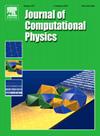RF-PINNs: Reactive flow physics-informed neural networks for field reconstruction of laminar and turbulent flames using sparse data
IF 3.8
2区 物理与天体物理
Q2 COMPUTER SCIENCE, INTERDISCIPLINARY APPLICATIONS
引用次数: 0
Abstract
Physics-Informed Neural Networks (PINNs) have emerged as a promising tool to model flow fields by embedding physical laws into neural networks and thereby reducing the dependency on data. While PINNs have shown substantial success in modeling non-reactive flows, their application for chemically reacting flows is less well understood. The overarching objective of this work is to propose reactive flow physics-informed neural networks (RF-PINNs) that reconstruct all flow quantities of interest solely based on sparse velocity profiles. We present RF-PINNs to reconstruct steady-state mean fields of premixed laminar and turbulent flames with sparse data. First, we extensively study a prototype flame to determine the best combination of governing equations to find a balance between prediction accuracy and optimization speed. We then demonstrate the RF-PINN prediction capabilities by utilizing measured velocity profiles to reconstruct the entire velocity, temperature, and density mean fields of laminar and turbulent flames. To highlight the bidirectional reconstruction capability, we utilize in the second step measured temperature profiles for both flames and, again, successfully reconstruct the flow fields of interest. For both scenarios, the subsequent comparison of predicted field quantities based on only 0.2% of the entire data set is sufficient for accurate field reconstruction. This study underscores the potential of RF-PINNs to complement comprehensive field data of laminar and turbulent reacting flows using both sparse and noisy experimental data.
求助全文
约1分钟内获得全文
求助全文
来源期刊

Journal of Computational Physics
物理-计算机:跨学科应用
CiteScore
7.60
自引率
14.60%
发文量
763
审稿时长
5.8 months
期刊介绍:
Journal of Computational Physics thoroughly treats the computational aspects of physical problems, presenting techniques for the numerical solution of mathematical equations arising in all areas of physics. The journal seeks to emphasize methods that cross disciplinary boundaries.
The Journal of Computational Physics also publishes short notes of 4 pages or less (including figures, tables, and references but excluding title pages). Letters to the Editor commenting on articles already published in this Journal will also be considered. Neither notes nor letters should have an abstract.
 求助内容:
求助内容: 应助结果提醒方式:
应助结果提醒方式:


